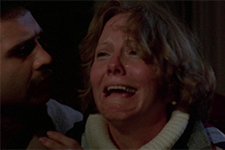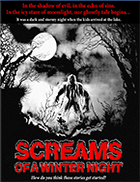Screams of a Winter Night
|  The 1970s was a golden age of low-budget American horror. The decade that began with Nixon and ended with Carter produced some of the most memorable of modern horror films, many of which succeeded despite their minimal budgets and launched the careers of their previously unknown directors: Bob Clark’s Deathdream (1972), Tobe Hooper’s The Texas Chain Saw Massacre (1974), Wes Craven’s The Hills Have Eyes (1977), John Carpenter’s Halloween (1978), and George A. Romero’s Martin (1976) and Dawn of the Dead (1978), to name but a few. These films were often visceral and terrifying, but they were also artistically clever and often had significant social and cultural issues lurking beneath their dark, grainy surfaces. These were the films that made the horror genre something to contend with again. Not usually included among that list is Screams of a Winter Night, a low-budget anthology film shot in Louisiana with a cast and crew of amateurs, and for good reason. Even though the film has developed enough of a cult following that Quentin Tarantino featured it in his 2007 Los Angeles Grindhouse Film Festival as one-half of the “70’s Low Budget Horror Combo” double feature (the other film was Stephen Traxler’s 1978 nuclear-mutant creature feature Slithis), it simply isn’t very good, even by compensatory low-budget standards. Anthology horror films like Tales From the Crypt (1972), From Beyond the Grave (1974), and Trilogy of Terror (1975) were popular in the 1970s, especially in England, partially because they allowed filmmakers to dabble in a number of different horror subgenres without having to commit to any one of them. Screams of a Winter Night follows a similar logic, although all four of its stories (only three of which were included in the original theatrical release) are of the classic campfire folklore variety, the kind that invariably end with “… and they found a bloody hook hanging from the door handle ….” or “ … and they were never seen again …” The stories themselves in Screams of a Winter Night are serviceable, and there are a few genuinely clever twists that may or may not defy logic. The inherent problem with the film is not the stories that are told, but rather the people who are telling them. The wraparound plot that justifies the inclusion of the horror tales centers on a large group of squabbling college students who, for reasons that are never made clear, drive out to a deserted cabin deep in the cypress-and-moss-filled Louisiana woods during the wintery off-season. The characters are all disagreeable, whether they are obnoxious, crude, shallow, or just bitchy, so there is little desire to spend much time with them. Unfortunately, screenwriter Richard H. Wadsack forces us to spend a solid half-hour with them before the first tale begins to unfold, perhaps in a desperate bid to get us to somehow care about them. Each of the stories is told by a different member of the group while they sit around on the living room floor drinking beer and occasionally pulling a scary prank. The characters in the stories are played by the same actors who appear in the wraparound plot, which seems like little more than a cost-saving approach to casting, although it is never terribly distracting. Like all anthology movies, the stories are a mixed bag, with some working better than others. The one involving a couple on a date getting stranded on a lonely country road at night when their car runs out of gas has a classic campfire vibe (the twist is the revelation of what the scrape-scrape sound on the roof of the car is), while the one involving a repressed young woman driven to murderous insanity by an attempted rape feels lazy and exploitative. There was some real potential in the one about three fraternity pledges forced to spend the night alone in an abandoned, possibly haunted hotel, but the effectiveness of the story is undermined by both its ill-timed deployment of physical comedy and its murky cinematography. This is generally true of the film as a whole, which suffers from a reliance on day-for-night murkiness, which robs it of any creative use of light and shadow (the cinematography was by Robert E. Rogers, who not surprisingly never shot another film). Virtually no one associated with Screams of a Winter Night went on to make anything else: Director James L. Wilson, who also produced, never directed anything again; likewise, screenwriter Richard H. Wadsack never wrote another script. Virtually no one from the cast, which was drawn almost entirely from a Louisiana-based theatre company, appeared in any subsequent movie roles outside of background walk-ons, with the exception of Gil Glasgow, who has been a regular presence in film and television as a supporting character actor, and William Ragsdale, who gained cult fame as the besieged teenage protagonist of Fright Night (1985) and the lead character in the television series Herman’s Head (1991–1994). The acting is mostly mediocre—just good enough not to draw you completely out of the experience, but never good enough to convince you that the characters are real people. What is most ironic about Screams of a Winter Night is the ending. Just when you think the film has nothing left to offer, that it has spent its meager resources and will go out with a whimper, it delivers a crazed, gonzo, slam-bang finale in which some supernatural entity in the woods around the cabin goes berserk and turns the generally staid proceedings into something resembling prom night in Carrie (1976) taking place inside a tornado (the legend of a “devil wind” mentioned early in the film is apparently all true). It comes completely out of left field and deploys elements of shock and horror and intensity that the rest of the film is studiously lacking. It is so deranged in its own wonderful way that it almost makes the rest of the film worth the slog to get there.
Copyright © 2022 James Kendrick Thoughts? E-mail James Kendrick All images copyright © Code Red / Kino Lorber | |||||||||||||||||||||||||||||
Overall Rating: 
 (2)
(2)


